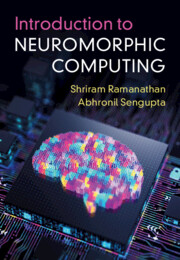Refine search
Actions for selected content:
48786 results in Computer Science
References
-
- Book:
- Cultures of Programming
- Published online:
- 19 December 2025
- Print publication:
- 08 January 2026, pp 309-331
-
- Chapter
-
- You have access
- Open access
- Export citation
7 - Telecommunications
-
- Book:
- Human–Computer Interaction and U.S. Law
- Published online:
- 12 December 2025
- Print publication:
- 08 January 2026, pp 173-197
-
- Chapter
- Export citation
1 - Introduction to Law for Human–Computer Interaction
-
- Book:
- Human–Computer Interaction and U.S. Law
- Published online:
- 12 December 2025
- Print publication:
- 08 January 2026, pp 1-20
-
- Chapter
- Export citation

Introduction to Neuromorphic Computing
- Coming soon
-
- Expected online publication date:
- January 2026
- Print publication:
- 22 January 2026
-
- Book
- Export citation
10 - Support Vector Machine Classifier
-
- Book:
- Machine Learning with Python
- Published online:
- 22 February 2025
- Print publication:
- 31 December 2025, pp 495-532
-
- Chapter
- Export citation
1 - Overview of Machine Learning
-
- Book:
- Machine Learning with Python
- Published online:
- 22 February 2025
- Print publication:
- 31 December 2025, pp 1-52
-
- Chapter
- Export citation
16 - Artificial Neural Network
-
- Book:
- Machine Learning with Python
- Published online:
- 22 February 2025
- Print publication:
- 31 December 2025, pp 821-864
-
- Chapter
- Export citation
13 - Implementation of Clustering
-
- Book:
- Machine Learning with Python
- Published online:
- 22 February 2025
- Print publication:
- 31 December 2025, pp 699-738
-
- Chapter
- Export citation
List of Figures
-
- Book:
- Machine Learning with Python
- Published online:
- 22 February 2025
- Print publication:
- 31 December 2025, pp xxiii-xlvi
-
- Chapter
- Export citation
14 - Association Mining
-
- Book:
- Machine Learning with Python
- Published online:
- 22 February 2025
- Print publication:
- 31 December 2025, pp 739-806
-
- Chapter
- Export citation
22 - Genetic Algorithm
-
- Book:
- Machine Learning with Python
- Published online:
- 22 February 2025
- Print publication:
- 31 December 2025, pp 1041-1084
-
- Chapter
- Export citation
3 - Data Pre-processing
-
- Book:
- Machine Learning with Python
- Published online:
- 22 February 2025
- Print publication:
- 31 December 2025, pp 125-154
-
- Chapter
- Export citation
2 - Introduction to Python
-
- Book:
- Machine Learning with Python
- Published online:
- 22 February 2025
- Print publication:
- 31 December 2025, pp 53-124
-
- Chapter
- Export citation
Frontmatter
-
- Book:
- Machine Learning with Python
- Published online:
- 22 February 2025
- Print publication:
- 31 December 2025, pp i-iv
-
- Chapter
- Export citation
5 - Simple Linear Regression
-
- Book:
- Machine Learning with Python
- Published online:
- 22 February 2025
- Print publication:
- 31 December 2025, pp 187-240
-
- Chapter
- Export citation
17 - Implementation of the ANN
-
- Book:
- Machine Learning with Python
- Published online:
- 22 February 2025
- Print publication:
- 31 December 2025, pp 865-888
-
- Chapter
- Export citation
15 - Implementation of Association Mining
-
- Book:
- Machine Learning with Python
- Published online:
- 22 February 2025
- Print publication:
- 31 December 2025, pp 807-820
-
- Chapter
- Export citation
4 - Implementing Data Pre-processing in Python
-
- Book:
- Machine Learning with Python
- Published online:
- 22 February 2025
- Print publication:
- 31 December 2025, pp 155-186
-
- Chapter
- Export citation
20 - Recurrent Neural Network
-
- Book:
- Machine Learning with Python
- Published online:
- 22 February 2025
- Print publication:
- 31 December 2025, pp 969-1006
-
- Chapter
- Export citation
Preface
-
- Book:
- Machine Learning with Python
- Published online:
- 22 February 2025
- Print publication:
- 31 December 2025, pp lvii-lviii
-
- Chapter
- Export citation
